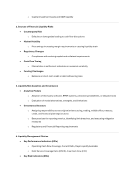CCRO Working Group:
Managing Financial Liquidity Risk
Managing Financial Liquidity Risk
Periods of extreme market volatility have brought financial liquidity risk to the forefront of challenges faced by
energy companies. In various global meetings, the CCRO membership agreed that clear guidance to identify,
measure, and manage this risk is essential. We propose a structured initiative to establish best practices,
benchmark industry norms, and create a shared knowledge resource for energy market participants.
Objectives of the Initiative
1. Survey Industry Practices
Conduct a comprehensive survey of CCRO members [and other market participants] to identify
current approaches for recognizing, measuring, and mitigating financial liquidity risk.
2. Create a Knowledge Repository
Compile a reference resource of published articles, regulatory guidelines, and industry insights on
financial liquidity risk.
3. Define a Liquidity Risk Framework
Based on member discussions across London, Boston, Houston, and Madrid, organize the
framework around key components:
o Understanding financial liquidity risk and its drivers
o Addressing specific liquidity risks by category
o Establishing governance and analytical best practices
Key Framework Components
1. Understanding Financial Liquidity Risk
• Drivers of Liquidity Risk
o Impacts of market volatility, market operators/clearing houses and counterparty behaviors
o Uncertainty in working capital components
• Market-Related Risks
o Exchange-cleared transactions: managing collateral and margin calls
o OTC financial and physical trades: addressing credit exposure, collateralization, and
payment terms
• Operational and Capital Liquidity Risks
o Delivered energy obligations, PPAs, and supply contracts
Managing Financial Liquidity Risk
Managing Financial Liquidity Risk
Periods of extreme market volatility have brought financial liquidity risk to the forefront of challenges faced by
energy companies. In various global meetings, the CCRO membership agreed that clear guidance to identify,
measure, and manage this risk is essential. We propose a structured initiative to establish best practices,
benchmark industry norms, and create a shared knowledge resource for energy market participants.
Objectives of the Initiative
1. Survey Industry Practices
Conduct a comprehensive survey of CCRO members [and other market participants] to identify
current approaches for recognizing, measuring, and mitigating financial liquidity risk.
2. Create a Knowledge Repository
Compile a reference resource of published articles, regulatory guidelines, and industry insights on
financial liquidity risk.
3. Define a Liquidity Risk Framework
Based on member discussions across London, Boston, Houston, and Madrid, organize the
framework around key components:
o Understanding financial liquidity risk and its drivers
o Addressing specific liquidity risks by category
o Establishing governance and analytical best practices
Key Framework Components
1. Understanding Financial Liquidity Risk
• Drivers of Liquidity Risk
o Impacts of market volatility, market operators/clearing houses and counterparty behaviors
o Uncertainty in working capital components
• Market-Related Risks
o Exchange-cleared transactions: managing collateral and margin calls
o OTC financial and physical trades: addressing credit exposure, collateralization, and
payment terms
• Operational and Capital Liquidity Risks
o Delivered energy obligations, PPAs, and supply contracts



